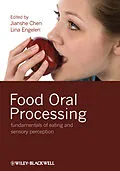This volume provides an overview of the latest research findings on the physics, physiology, and psychology of food oral consumption, as well as the experimental techniques available for food oral studies. Coverage includes the main physical and physiological functionalities of the mouth; the location and functionalities of various oral receptors; the main sequences of eating and drinking, and the concomitant food disintegration and destabilisation. Chapters also explain oral processing and its relation to flavour release and texture perception, and there is an introduction to the principles of food rheology as they relate to eating.
Food Oral Processing is directed at food scientists and technologists in industry and academia, especially those involved in sensory science and new product development. It will also be of interest to oral physiologists, oral biologists and dentists. The book will be a useful reference for undergraduate and postgraduate students of these disciplines.
Autorentext
Dr Jianshe Chen is Senior Lecturer in the School of Food Science and Nutrition, University of Leeds, UK.
Dr Lina Engelen is Research Fellow in the Faculty of Health Sciences, University of Sydney, Australia.
Klappentext
'It is critically important not only what we eat but also how we eat!'
Eating and drinking are essential daily activities, providing us with the energy and nutrients we require as well as great sensory pleasure and enjoyment. The practices of eating and drinking are known to everyone, but the physical, physiological and psychological principles involved are not as obvious.
The eating quality and sensory experience of a food always remains a top concern to food researchers, food manufacturers and retailers, as well as consumers. Eating is no longer seen as a simple process of food breakdown, but is recognised as a highly sophisticated process of human responses to the changing physicochemical properties of the food.
This book reviews the latest research findings on food oral processing and sensory perception, providing readers with up-to-date knowledge and understanding of the underpinning principles of food physics, oral physiology, and sensory psychology of an eating process as well as the experimental techniques available for food oral studies. A range of topics are covered, including the main physical and physiological functionalities of the mouth, the location and functionalities of various oral receptors and receptor organs (such as taste buds), the main sequences of eating and drinking, and the associated food disintegration and destabilisation. Emphasis is given to the significance of oral processing for sensory perception, food texture, flavour release, new product development and nutrition.
Food Oral Processing will be of interest to food scientists and technologists in industry and academia, especially those involved in sensory science and new product development. It will also appeal to oral physiologists, oral biologists and dentists. The book will be a valuable reference for undergraduate and postgraduate students of these disciplines.
Inhalt
Here is the revised text with only person names wrapped in asterisks:
Preface xiv
Contributors xvii
Part One Oral Anatomy and Physiology 1
1 Oral Cavity 3
Luciano José Pereira
1.1 Introduction 3
1.2 The oral cavity 3
1.3 Salivary glands and saliva secretion 6
1.4 Orofacial muscles 7
1.5 The tongue 9
1.6 Concluding remarks 12
Acknowledgements 12
References 13
2 Oral Receptors 15
LinaEngelen
2.1 Introduction to oral receptors 15
2.1.1 Babies sense the world around them through the mouth 15
2.1.2 Receptors 15
2.1.3 Innervation and transduction 16
2.2 Taste 17
2.2.1 Taste receptors 18
2.2.2 Taste molecules and modalities 20
2.2.2.1 What substances give rise to the different sensations? 20
2.3 Mechanoreception 22
2.3.1 Tactile stimulation 22
2.3.2 Function during eating 23
2.3.3 Mechanoreceptors in the mouth 24
2.3.3.1 SA1 form and texture 25
2.3.3.2 Fa 1 25
2.3.3.3 SA2 shape and position of tongue 25
2.3.4 Proprioceptors 26
2.3.4.1 Proprioception 26
2.3.4.2 Muscle spindles 27
2.3.4.3 Golgi tendon organ 27
2.3.4.4 Mechanoreceptors as proprioceptors 28
2.3.5 Periodontal receptors 28
2.3.5.1 Function of periodontal receptors 28
2.3.6 Signal transduction and central processing 29
2.4 Nociception 30
2.4.1 Nociceptors 30
2.4.2 Nociception in food 31
2.4.3 Nociceptive transduction 32
2.5 Thermal perception 33
2.5.1 Thermal sensation 33
2.5.2 Thermoreceptors 34
2.5.3 Thermal transduction 34
2.5.4 Temperature and food 35
2.5.5 The thermoreception and nociception relation 36
2.6 Olfaction 36
2.6.1 Olfaction and food 36
2.6.2 Olfactory receptors and transduction 37
2.7 Concluding remarks 38
References 38
3 Role of Saliva in the Oral Processing of Food 45
Guy Carpenter
3.1 Introduction 45
3.2 Control of salivary secretion 46
3.3 Functionalities of saliva 50
3.3.1 Salivary interactions with the oral mucosa 51
3.3.2 Perception of taste 52
3.3.3 Protection of the oral environment 53
3.4 Saliva in bolus formation, swallowing and oral clearance 54
3.4.1 Bolus formation and swallowing 54
3.4.2 Post-mastication oral clearance 54
3.5 Concluding remarks 56
Acknowledgements 56
References 57
Part Two FOOD ORAL MANAGEMENT 61
4 Oral Management of Food 63
Andriesvan derBilt
4.1 Introduction 63
4.2 Factors influencing oral function 63
4.2.1 Dental factors 66
4.2.2 Jaw muscle activity (EMG) and bite force 67
4.2.3 Masticatory performance 68
4.2.4 Swallowing of food 69
4.2.5 Saliva 70
4.3 Influence of food characteristics on chewing 72
4.3.1 Influence of food type on muscle activity, chewing force and jaw movement 74
4.3.2 Crispy food 75
4.3.3 Influence of food type and volume on swallowing 75
4.3.4 Muscle activity and jaw movement in various phases of chewing 78
4.4 Neuromuscular control of chewing and swallowing 79
4.4.1 Cortical masticatory area 80
4.4.2 Central pattern generator 80
4.4.3 Peripheral feedback 80
4.4.4 Simulated chewing experiments 81
4.4.5 Neuromuscular control of chewing crispy food 83
4.5 Concluding remarks 84
References 85
5 Breaking and Mastication of Solid Foods 95
Carolyn F. R...
